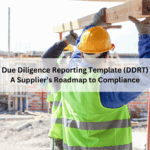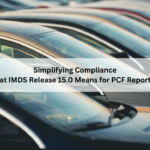In a time of increased regulatory scrutiny and the demand for sustainable production, the aerospace and defense (A&D) industries are under growing pressure to strengthen chemical compliance control. The Aerospace and Defense Declarable Substances List (AD-DSL) is a critical resource for this effort.
Understanding AD-DSL is essential for maintaining compliance, protecting workers and the environment, and ensuring seamless collaboration with key industry partners—whether a company is an A&D supplier, manufacturer, or integrator.
What is AD-DSL?
The Aerospace and Defense Declarable Substances List (AD-DSL) is a standardized list of chemical substances that are restricted, prohibited, or require reporting within the aerospace and defense industry.
It is administered by the International Aerospace Environmental Group (IAEG) and specifies which substances must be declared when used in components, materials, or production processes.
AD-DSL is part of the broader IAEG material declaration framework (based on IEC 62474) and works alongside tools such as the AD-SRT (Substance Reporting Tool) to harmonize reporting requirements across organizations and regions.
Why Was AD-DSL Created?
The aerospace and defense industry relies on thousands of components sourced from complex global supply chains. With regulations such as REACH, RoHS, and TSCA, tracking restricted substances has become increasingly difficult.
AD-DSL was developed to:
- Ensure compliance with customer and regulatory requirements.
- Safeguard product performance and safety.
- Prevent the use of restricted or high-risk substances.
By consolidating substances of regulatory or industry concern into a single harmonized list, AD-DSL enables all stakeholders to communicate using a common compliance language.
What’s on the AD-DSL?
The AD-DSL includes detailed information such as:
- Substance name and identification (CAS/EC number).
- Regulatory drivers (REACH SVHCs, RoHS restrictions, TSCA).
- Reporting thresholds.
- Relevant applications (e.g., coatings, electronics, adhesives).
- Declaration justifications (banned, toxic, critical use, etc.).
Examples of chemicals listed:
- Heavy metals (e.g., cadmium, lead, mercury).
- Halogenated flame retardants and PFAS (per- and polyfluoroalkyl substances).
- Phthalates and plasticizers.
- Carcinogens, including chromates.
The list is updated regularly to reflect global regulatory developments and industry best practices.
Who Needs to Use AD-DSL?
The AD-DSL applies across the entire aerospace and defense supply chain, including:
- OEMs (Original Equipment Manufacturers).
- Tier 1 and Tier 2 suppliers, as well as raw material providers.
- Component and sub-assembly manufacturers.
If products, parts, or materials are supplied to aerospace or defense customers, it is likely that AD-DSL compliance and substance declarations will be required.
How is AD-DSL Used in Practice?
- Material declarations: Suppliers must report whether AD-DSL substances are present using standard reporting formats such as IPC-1754 or AD-SRT.
- Data sharing: OEMs collect and review data to ensure compliance, assess risks, and meet regulatory obligations.
- Lifecycle analysis: AD-DSL declarations inform environmental assessments, waste management, and recycling strategies.
Benefits of Using AD-DSL
- Streamlined compliance: Reduces duplicative reporting and customer-specific questionnaires.
- Risk reduction: Identifies regulatory and reputational risks early in the design or sourcing process.
- Transparency: Standardized data builds trust with customers and regulators.
- Efficient supplier communication: Facilitates fast, accurate, and consistent substance reporting across the supply chain.
Staying Up to Date
AD-DSL is not static. As global regulations evolve and industries shift toward safer alternatives, the IAEG updates the list on a regular basis.
To stay compliant, companies should:
- Subscribe to AD-DSL updates.
- Review Bills of Materials (BoMs) regularly.
- Collaborate with suppliers to collect updated declarations.
- Use compatible reporting tools (e.g., AD-SRT, IPC-1754).
AD-DSL is more than just a list—it is a strategic tool for compliance and sustainability in the aerospace and defense industries. As regulatory expectations rise, organizations that adopt the AD-DSL framework will be better positioned to ensure business continuity, meet customer requirements, and drive responsible innovation.
At ComplianceXL, we help clients understand and assess their products against AD-DSL requirements to stay ahead of compliance challenges.
FAQs:
1. What is AD-DSL?
The Aerospace and Defense Declarable Substances List (AD-DSL) is a harmonized list of chemical substances that must be declared when materials, parts, or products are supplied to the aerospace and defense industry. It ensures compliance with global regulations and customer-specific requirements.
2. Why is AD-DSL important?
AD-DSL helps companies:
- Stay compliant with regulations such as REACH, RoHS, and TSCA.
- Increase supply chain transparency.
- Avoid the use of restricted or prohibited substances.
- Promote sustainability and material innovation.
- Meet customer contractual obligations.
3. Who should comply with AD-DSL?
All suppliers and manufacturers in the aerospace and defense supply chain—including raw material providers, component manufacturers, and OEMs—must declare substances listed in the AD-DSL when delivering products.





